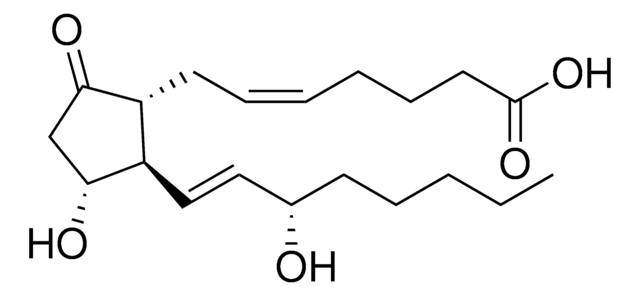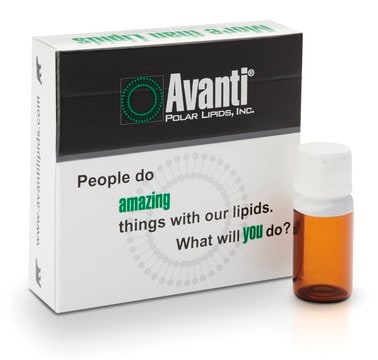Kluczowe dokumenty
L5011
Leukotriene D4
~50 μg/mL (in methanol/ammonium acetate buffer, 70:30, pH 5.6), ≥97%
Synonim(y):
LTD4
About This Item
Polecane produkty
Poziom jakości
Próba
≥97%
stężenie
~50 μg/mL (in methanol/ammonium acetate buffer, 70:30, pH 5.6)
Warunki transportu
dry ice
temp. przechowywania
−70°C
ciąg SMILES
CCCCC\C=C\C/C=C\C=C\C=C\[C@@H](SC[C@@H](N)C(=O)NCC(O)=O)[C@@H](O)CCCC(O)=O
InChI
1S/C25H40N2O6S/c1-2-3-4-5-6-7-8-9-10-11-12-13-16-22(21(28)15-14-17-23(29)30)34-19-20(26)25(33)27-18-24(31)32/h6-7,9-13,16,20-22,28H,2-5,8,14-15,17-19,26H2,1H3,(H,27,33)(H,29,30)(H,31,32)/b7-6+,10-9-,12-11+,16-13+/t20-,21+,22-/m1/s1
Klucz InChI
YEESKJGWJFYOOK-GKWRKXFUSA-N
Powiązane kategorie
Działania biochem./fizjol.
Cechy i korzyści
Opakowanie
Hasło ostrzegawcze
Danger
Zwroty wskazujące rodzaj zagrożenia
Zwroty wskazujące środki ostrożności
Klasyfikacja zagrożeń
Acute Tox. 3 Dermal - Acute Tox. 3 Inhalation - Acute Tox. 3 Oral - Flam. Liq. 2 - STOT SE 1
Organy docelowe
Eyes
Kod klasy składowania
3 - Flammable liquids
Klasa zagrożenia wodnego (WGK)
WGK 3
Temperatura zapłonu (°F)
49.5 °F
Temperatura zapłonu (°C)
9.7 °C
Środki ochrony indywidualnej
Eyeshields, Faceshields, Gloves, type ABEK (EN14387) respirator filter
Wykazy regulacyjne
Wykazy regulacyjne dotyczą głównie produktów chemicznych. Można w nich podawać ograniczoną liczbę informacji na temat produktów niechemicznych. Brak wpisu oznacza, że żaden ze składników nie znajduje się w wykazie. Użytkownik odpowiada za zagwarantowanie bezpiecznego i zgodnego z prawem stosowania produktu.
EU REACH Annex XVII (Restriction List)
Wybierz jedną z najnowszych wersji:
Masz już ten produkt?
Dokumenty związane z niedawno zakupionymi produktami zostały zamieszczone w Bibliotece dokumentów.
Nasz zespół naukowców ma doświadczenie we wszystkich obszarach badań, w tym w naukach przyrodniczych, materiałoznawstwie, syntezie chemicznej, chromatografii, analityce i wielu innych dziedzinach.
Skontaktuj się z zespołem ds. pomocy technicznej











